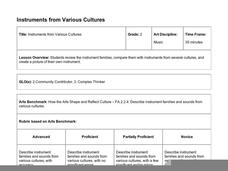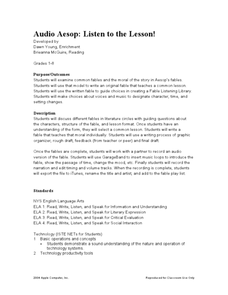Curated OER
Illustration # 1: Source of Illustration
Students play a game of imitating steady beats by mimicking the instructor. They use drums and repeat the game by echoing rhythmic patterns. The patterns may vary in degree of difficulty according to each individual's ability.
Curated OER
Willie Nelson: All Together Now!
Young scholars recite Willie Nelson's lyrics in one voice and then analyze their tone and vocabulary usage. They research Willie Nelson's history and dramatize the song: "On the Road Again."
Curated OER
The Life and Times of Gioacchino Rossini
Students discuss Gioacchino Rossini's life and musical culture. In this music activity, students are introduced to "biofacts" about Rossini and listen to excerpts of his music. Students identify characteristics of Rossini's musical...
Curated OER
Everybody's Boppin', Lambert, Hendricks and Ross
Learners probe the musical style of scat singing with imitation instruments. While listening to the musical pieces, they identify when one singer finishes and another begins. The singing groups' styles are contrasted in this activity.
Curated OER
My Favorite Things
Fourth graders listen to the song "My Favorite Things" from The Sound of Music. In this singing lesson, 4th graders discuss the words of the song and also find where the note goes upward. Students write down what their favorite things are.
Curated OER
Dynamics
Third graders recognize and identify the three types of balance. They analyze and identify the type of balance used in various works of art. Students create a symmetrically balanced work of art. They use a ruler, shape templates, an...
Curated OER
Hole Hole Bushi
Fourth graders play a written rhythm pattern. They state when a rhythm pattern varies from a given pattern by listening to an ostinato. They state reasons why people migrate to different lands.
Curated OER
Mural to Music 2
Students make a collaborative mural drawing to music using invented sign language, music and their responses to music. They select the music to be played while they are drawing. As the music stops, students move to a new location on the...
Curated OER
Got The Beat
Young scholars listen to song in which they identify the beat. Listening to the song again, they clap and march to the beat after being introduced to the new vocabulary. They complete the same exercises for other songs played in class.
Perkins School for the Blind
Familiar Sounds
To foster concept development and auditory discrimination skills, learners with visual impairments listen to identify a variety of common sounds. The teacher makes recordings of various sounds, including those found in the home, at the...
Hawaiʻi State Department of Education
Instruments from Various Cultures
After a review of orchestral instruments and instrument families, learners make their own. They listen to the song "Simple Gifts" and identify the instruments heard in the piece. Then they draw an instrument of their own invention,...
Curated OER
Reinforcing Alphabet Names/Sounds
Getting comfortable with the sounds associated with each letter is crucial in a young learner's path to becoming literate. This lesson plan provides a terrific way to reinforce this skill in an engaging and fun manner. It's a game that...
Curated OER
Audio Aesop: Listen to the Lesson!
Aesop's Fables are the focus of this language arts lesson. Young philosophers study and discuss the morals found in the most famous of Aesop's Fables. They write an original fable that teaches a common moral. A "Fable Listening Library"...
Curated OER
Lesson Plan for C.S Lewis’ The Magician’s Nephew
Here is a lesson that incorporates music writing, and reading literature. The class reads chapter eight from the C.S. Lewis classic The Magician's Nephew. Then, just like in the story, they use music as inspiration to create (write)...
Curated OER
Jazz in America Lesson Plan 7
The student will explore free jazz, fusion, and contemporary jazz. They will listen to avant garde, fusion, and pop recordings. In addition, they participate in a class discussion regarding jazz's contribution to and reflection of...
It's About Time
Sounds in Strings
How many of your pupils play an instrument? A musical science lesson will help all of them understand how string instruments work. Young scientists construct a string-and-pulley system to test frequency and pitch. The lesson...
Curated OER
Introduce a Weather Unit
Engage your learners by playing Water Music Suite by Handel. Different types of weather sounds play on the recording, and it's an easy lead into talking about the weather! What is weather? What kinds of weather exist? What is it called...
Curated OER
Deutschland und die Europäische Union (Germany and the European Union)
Introduce your language learners in German class to the European Union, including the historic developments, the current structure, and some of the political and social principles behind it with this lesson. In small groups, learners...
Curated OER
Bud, Not Buddy: Guided Imagery Exercise
Develop readers’ awareness of the visual power of language with a guided imagery exercise. Set the stage and create the mood with dim lights, soft music and potpourri. Then read the provided section of Bud, Not Buddy. Next, invite...
Curated OER
Beautiful Noise Poetry
"What a beautiful noise comin' up from the street; got a beautiful sound, it's got a beautiful beat..." Use Neil Diamond's "Beautiful Noise" to guide your class through a Six Trait writing activity, in which they write an original poem...
Computer Science Unplugged
The Intelligent Piece of Paper
How smart is that piece of paper? The activity introduces the idea of computer programming as a list of instructions written by computer programmers. Two individuals play a game of Tic-Tac-Toe in which one follows the commands...
Curated OER
Around the World in 180 Days
Where did I come from? How did I come to be in this classroom? Using curriculum from Kidspiration, class members research the homelands of their ancestors, as well as the journeys that began from many parts of the world and ended with...
Peace Corps
Brief Encounters
How are Pandyas different than Chispas? Explore cultural norms and societal behaviors with an engaging role-play activity. Split into groups of two hypothetical cultural groups, the formal Pandyas and the sociable Chispas, and another...
Florida Center for Reading Research
Phonological Awareness: Rhyme, Rhyme or No Rhyme
Rhyming is fun, builds phonemic awareness, and is a tried and true pre-reading skill. This activity helps learners identify words that rhyme. Young scholars listen to a song, locate a rhyming word they hear by clapping then draw a...























